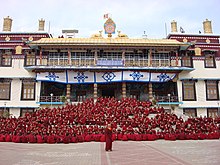
Back دير سيرا ARZ སེ་ར་དགོན། Tibetan Monestir Sera Catalan Sera Czech Sera German Monasterio Sera Spanish Monastère de Séra French सेरा मठ Hindi Szera kolostor Hungarian Sera (monastero) Italian
| Séra Monastery | |
|---|---|
Tibetan transcription(s) Tibetan: སེ་ར་ཐེག་ཆེན་གླིང་། Wylie transliteration: se ra theg chen gling Chinese transcription(s) Traditional: 色拉寺 Simplified: 色拉寺 | |
 Monks assembled outside the Sera Me Tratsang college of Sera Monastery in India in December 2006. | |
| Religion | |
| Affiliation | Tibetan Buddhism |
| Sect | Gelug |
| Deity | Je Tsongkhapa |
| Location | |
| Location | Wangbur Mountain, Lhasa, Tibet Autonomous Region, China |
| Country | China |
| Geographic coordinates | 29°41′53″N 91°8′0″E / 29.69806°N 91.13333°E |
| Architecture | |
| Founder | Jamchen Chojey |
| Its counterpart set up at Bylakuppe, near Mysore in Karnataka by Tibetan diaspora | |
| Part of a series on |
| Tibetan Buddhism |
|---|
 |
Sera Monastery (Tibetan: སེ་ར་དགོན་པ, Wylie: se ra dgon pa "Wild Roses Monastery";[1] Chinese: 色拉寺; pinyin: Sèlā Sì) is one of the "great three" Gelug university monasteries of Tibet, located 1.25 miles (2.01 km) north of Lhasa and about 5 km (3.1 mi) north of the Jokhang.[2] (The other two are Ganden Monastery and Drepung Monastery.)
The origin of its name is attributed to a fact that during construction, the hill behind the monastery was covered with blooming wild roses (or "sera" in Tibetan).[1] (An alternate etymology holds that the location that was surrounded by raspberry shrubs called 'Sewa' in Tibetan, that formed like a 'Rawa' in Tibetan, meaning "Fence".)[3]
The original Sera Monastery is responsible for some 19 hermitages, including four nunneries, which are all located in the foothills north of Lhasa.[4][5]
The Sera Monastery, as a complex of structures with the Great Assembly Hall and three colleges, was founded in 1419 by Jamchen Chojey of Sakya Yeshe of Zel Gungtang (1355–1435), a disciple of Je Tsongkhapa.[6] During the 1959 revolt in Lhasa, Sera monastery suffered severe damage, with its colleges destroyed and hundreds of monks killed.[7]
After the Dalai Lama took asylum in India, many of the monks of Sera who survived the attack moved to Bylakuppe in Mysore, India. After initial tribulations, they established a parallel Sera Monastery with Sera Me and Sera Je colleges and a Great Assembly Hall on similar lines to the original monastery, with help from the Government of India. There are now 3000 or more monks living in Sera, India and this community has also spread its missionary activities to several countries by establishing Dharma centres, propagating knowledge of Buddhism.[3][8]
Sera Monastery in Tibet and its counterpart in Mysore, India are noted for their debate sessions.
- ^ a b "Drepung & Sera Monastery on Budget-Lhasa Day Tour". Lonely Planet. Archived from the original on 21 August 2019. Retrieved 28 October 2018.
- ^ Majupuria, Trilok Chandra; Majupuria, Indra (1988). Tibet, a guide to the land of fascination: an overall perspective of Tibet of the ancient, medieval, and modern periods. S. Devi. p. 312.
- ^ a b Cite error: The named reference
Historywas invoked but never defined (see the help page). - ^ "Buddhist Monk of Sera Monastery, Lhasa, Tibet". pp. 9–12. Retrieved 2010-02-09.
- ^ "Travel China guide:Sera Monastery". Retrieved 27 February 2010.
- ^ Dorje, Gyumye (1999). Tibet handbook: with Bhutan. Footprint Travel Guides. pp. 119–122–130. ISBN 1-900949-33-4. Retrieved 26 February 2010.
{{cite book}}:|work=ignored (help) - ^ Mayhew, Bradley; Michael Kohn (2005). Tibet. Lonely Planet. pp. 123–125. ISBN 1-74059-523-8. Retrieved 1 March 2010.
{{cite book}}:|work=ignored (help) - ^ Cite error: The named reference
thlibwas invoked but never defined (see the help page).
